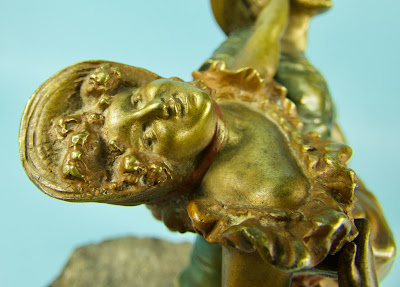Won't you come and splash me, splash me,
In the ocean blue?
This is not the place to mash me, mash me,
But we oughtter get into the water!
Then when Percy said, "Oh,
Lou is that the thing to do?"
She said, "Come along and splash me,
And I'll splash you!"
You Splash Me and I'll Splash You,
Alfred Solman and Arthur J. Lamb, 1907
This post features another pair of bronze beachgoers, engaging in a bit of frolicsome seaside shenanigans. The man is carrying his buxom bathing belle to the edge of the stone on which they stand, no doubt to dunk the damsel in the sea. Although she struggles, their laughing expressions indicate it is all in good fun. Of gilt bronze with translucent cold-painted coloring, this 8-inch tall sculpture is superbly detailed, from the man's straw hat and his lady's tumbling tresses to the folds of their swimwear and the realistic modeling of their anatomy. Stamped on woman's left hip is a "B" in stylized urn, "Gesch," and "4133." The urn mark is of the Viennese foundry of Franz Xaver Bergmann, which produced fine quality bronze sculptures from the 1860s until 1936. "Gesch" is an abbreviation for "gesetzlich geschutzt," which means that patent rights have been granted and registered for the design. I have seen another example of this scene with the couple cavorting on a bronze pier, which indicates the Bergmann offered this sightly risqué revel on a number of different bases.






No comments:
Post a Comment